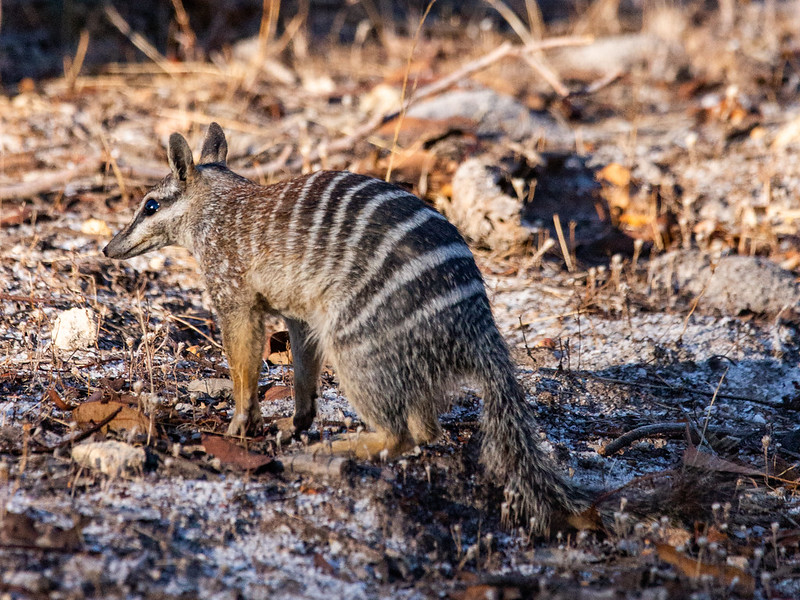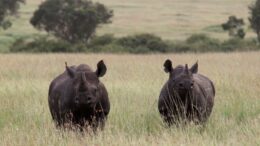The world continues to hit alarming records. Last year was the warmest since record keeping began in 1850. And the 10 warmest years have all occurred in the past decade. The implications for life on Earth are vast. More than 1 million species are already at risk of extinction — a number that’s likely to increase with climate pressures.
Researchers are rushing to understand how a quickly changing planet affects myriad species of plants and animals. One thing is certain: There’s still much we don’t know. Frogs, for example, are succumbing to mass mortalities as heat waves push temperatures above thresholds they can tolerate. But researchers found that we don’t even know the heat tolerance for 93% of described amphibian species.
One of the things we do know is that people need to act quickly to halt climate emissions, and while they do, many plants and animals have just two choices: adapt or move.
Some species are already doing this. “Dark-colored dragonflies are getting paler in order to reduce the amount of heat they absorb from the sun,” wrote biologist Michael P. Moore and evolutionary ecologist James T. Stroud in The Conversation. “Mustard plants are flowering earlier to take advantage of earlier snowmelt. Lizards are becoming more cold-tolerant to handle the extreme variability of our new climate.”
But for many species, adaptation or migration is a task made difficult or impossible by physiology or other human impacts to the environment.
Some recent scientific findings shed light on why.
Concerning Numbers for Numbats
Climate change may pose an existential threat to numbats, endangered Australian marsupials already struggling to fend off threats from habitat loss, domestic cats and red foxes. Numbats are among the few marsupials active during the day, which is when they need to be out and about to feed on termites. But their bodies can’t cope well when it gets too hot.
A new study that used infrared cameras found that numbats experience heat gain even in the shade. Heat that radiates off objects, as well as heat from the ground and air, can cause them to overheat. When ground and air temperatures reach 23°C, numbats can only spend 10 minutes in the sun before getting too hot.
Climate change may leave them with two bad choices: reducing the time they spend looking for food or moving those activities into times when they’re at a higher risk of predation.

The Heat Is On … Birds
A study published in January in Global Change Biology assessed how birds in arid areas were coping with heat waves. “Understanding which birds are most vulnerable to heat waves, and where these birds occur, can offer a scientific basis for adaptive management and conservation,” the researchers wrote.
They studied the vulnerability of nearly 1,200 dryland bird species and found that the vast majority — 888 species — are vulnerable, including 170 that would be “highly vulnerable” and eight “extremely vulnerable.” The biggest hot spots were in Australia, southern Africa and eastern Africa.
While most of the species — about 91% — aren’t threatened or endangered now, the researchers warned that with a warming planet that could change. The finding “suggests that many species will likely become newly threatened with intensifying climate change,” they wrote.
Too Hot for Rhinos
There’s more bad news for animals in arid areas. Unchecked climate change will have dire consequences for white and black African rhinos in southern Africa, where most of these animals live.
A new study in Biodiversity found under a worst-case emissions scenario, by 2085 the rhinos wouldn’t be able to survive in the region’s national parks. Rhinos lack the ability to sweat as a mechanism for evaporative cooling. They can drink more water, wallow, and hang out in the shade, but the researchers say that when temperatures pass a certain threshold that simply won’t be enough to keep them cool. Development makes the situation worse, as rhinos are constrained from migrating by human settlements.
Fish and Their Food
Warming ocean waters can disrupt the ocean food web — starting at the bottom with phytoplankton, tiny bits of algae that are consumed by larger organisms like zooplankton, and then fish. When climate warming reduces phytoplankton in the ocean by 16%-26%, it has an outsized impact on fish, sending their numbers down 38%-55%, according to researchers of a new study in Nature Communications.
The researchers found that temperature doesn’t reduce the amount of phytoplankton, but it does reduce their size, which makes eating enough more challenging for fish.
“Our global analysis sheds light on a hidden vulnerability,” marine ecologist Angus Atkinson, the study’s lead author, told the press. “We see ecosystems adapting to warming by changing plankton size. This suggests the main threat comes from reduced nutrient supply, leading to smaller plankton, longer food chains, and inefficient foraging.”
The researchers also warn that some of the biggest declines could happen in areas with concentrated fishing activity.
When ocean heat records were shattered last year, phytoplankton and associated fish populations felt the effects. Previous research has already found losses of phytoplankton in the Atlantic Ocean, including the Gulf of Maine. And that’s significant not just for marine organisms but also for the rest of us, as phytoplankton also helps store carbon.
Mismatched Timing
Timing is everything in nature. Researchers in Spain looked at 51 species of flowering shrubs, bushes and trees in Doñana National Park and found that warming temperatures have changed the peak flowering time, moving it forward 22 days. And the duration of flowering also shifted for some species. Their study, published in the Annals of Botany, showed that more than half of the species now flower in a more crowded time, leading to increased competition to attract pollinators.
In another study examining the timing of biological events, researchers looking at plants in North America found that warmer spring temperatures caused trees to leaf out earlier, which reduced the amount of time that wildflowers below the trees had to enjoy sunlight before being covered by the tree canopy. Shorter periods of sunlight, they reported, means that the wildflowers have less energy to grow and reproduce — which could lead to future population declines.
We still have a lot to learn about how climate change will affect plants and animals, but the more we look, the more we find species already struggling. Those who lack the ability to move or adapt may soon suffer the consequences of our inaction, especially if we continue to ignore them.
“The evidence indicates that humanity cannot simply assume that plants and animals will be able to save themselves from climate change,” write Moore and Stroud. “To protect these species, humans will have to stop the activities that are fueling climate change.”
Previously in the Revelator:
For Species That Rely on Wind, Climate Change Won’t Be a Breeze


